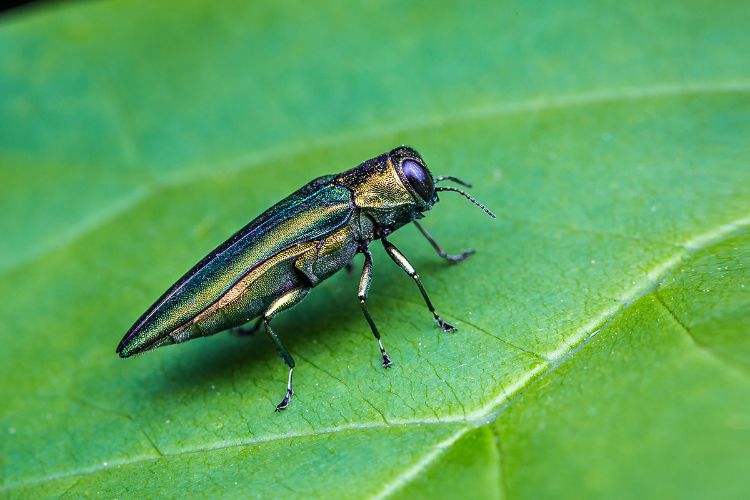Project GREEEN advancing research on harmful plant insects
MSU researchers use Project GREEEN funding to mitigate damage from some of the most destructive insects in Michigan agriculture.
EAST LANSING, Mich. — With vibrant and valuable forestry and plant agriculture industries in Michigan, there are a multitude of reasons forest managers and growers want to protect plants.
According to the Michigan Department of Natural Resources (MDNR), forest products create roughly $22 billion in total economic output annually for the state. The Michigan Department of Agriculture and Rural Development (MDARD) reports $753 million as the total economic impact of the Michigan fruit industry, along with $428.2 million for vegetables and $1.26 billion for nursery and landscape crops.
Needless to say, plants are big business in Michigan. So when they are threatened by native and invasive insects, Michigan State University researchers are called upon to assist with the problem.

Using resources from Project GREEEN — Michigan’s plant agriculture initiative through MSU, MDARD and the Plant Coalition — MSU scientists have been addressing emerging and pervasive insect challenges for more than 25 years across an array of plant industries. These preliminary findings have often led to large federal grants from agencies such as the U.S. Forest Service and the U.S. Department of Agriculture's (USDA) National Institute of Food and Agriculture to further explore the issues.
Deborah McCullough, a professor in the MSU departments of Entomology and Forestry, has been the beneficiary of Project GREEEN funding since the program’s beginnings. One of her initial studies through Project GREEEN focused on emerald ash borer (EAB), which was first discovered in Michigan in 2002 by McCullough and scientists from MDNR, MDARD, and the USDA’s Animal and Plant Health Inspection Service (USDA APHIS).
According to McCullough, EAB has since become the most destructive forest insect to ever invade North America. Hundreds of millions of ash trees have been killed by EAB in the eastern U.S. and Canada, costing cities and private landowners billions of dollars and causing untold ecological damage in forested areas.
“Project GREEEN funding was extremely important to much of our early work with EAB,” said McCullough, whose work is supported in part by MSU AgBioResearch. “This included figuring out basics about the lifecycle and behavior of this insect, which led to evaluating survey and management options. Our preliminary work helped to leverage additional federal dollars, and although EAB is still causing many problems, we’ve been able to offer forest and urban forest managers some tools to deal with it.”
Her initial work involved discovering ways to detect new EAB infestations, comparing the vulnerability of native ash species to EAB, and developing guidelines for protecting ash trees in urban and forested areas. With Project GREEEN funding, she helped create some of the earliest EAB resources for forest managers and the general public.
Roughly a half inch in length, adult EAB shimmer with distinctive metallic-green wings and a shiny purple abdomen. While flashy in appearance, mature beetles are not much of a concern to ash trees as they nibble on leaves. The larvae, however, can cause irreparable injury.
McCullough and other scientists discovered that EAB lay eggs during the summer, which hatch within two weeks. The larvae burrow through the outer bark to feed on the inner bark in distinct serpentine tunnels called galleries. Most ash trees can cope with a few galleries, but as EAB densities build, the larval feeding interferes with the tree’s ability to transport nutrients and water. Branches die, tree canopies become thin, and eventually the entire tree is killed.

As researchers learned more about EAB behavior and activity, McCullough and her team began testing systemic insecticides, including newly developed compounds and application methods. They compared the effectiveness of different products and their ability to protect ash trees over time.
“Unnecessary applications obviously waste money,” McCullough said. “But waiting until the insect has already injured the tree’s vascular system can hinder the chances of success, so it’s a delicate balance.”
Eventually, McCullough and other scientists found that certain compounds applied by injecting the product into the tree base could protect ash trees for up to three years.
Researchers developed recommendations for forest managers and property owners who wished to conserve genetic diversity and slow EAB population growth, as well as arborists who needed to protect individual trees.
Collaborations with economists also showed that protecting landscape ash trees in residential or urban areas with systemic products was less expensive than removing the trees. McCullough said these recommendations continue to be widely used in the 36 states where EAB is established.
More recently, with support from the U.S. Forest Service and others, McCullough, partner researchers and Indigenous groups modeled EAB spread and projected the effects on black ash, the most vulnerable species EAB has encountered.
Results showed that by 2035, 75% of large black ash trees will be dead across most (87%) of their native range. This was coupled with using U.S. Census data to quantify the effect on Indigenous groups that have valued black ash as a cultural resource for generations.
“Although this project didn’t start with Project GREEEN funding, all of my EAB work has roots there,” McCullough said. “Project GREEEN enabled us to begin our research right away, well before federal agencies understood the scope of what this invader was going to do. We continue to explore ways to mitigate the damage from this insect, and we couldn’t have done that without Project GREEEN.”
Tree fruit troubles
Not unlike EAB, the Michigan tree fruit industry has experienced a number of problematic pests over the years. Arguably the most difficult to manage has been spotted wing drosophila (SWD), a small vinegar fly native to Asia that’s about the size of a grain of rice.
First discovered in West Michigan in 2010 by MSU researchers, SWD has presented some unique challenges to growers of soft-fleshed fruits such as berries and cherries. MSU scientists have been at the forefront of addressing the problem, using Project GREEEN funds to learn more about SWD, its behavior and ways to protect tree fruit.
Rufus Isaacs, a University Distinguished Professor in the Department of Entomology, was one of the first to discover the pest in Michigan. Working closely with him throughout that time has been Julianna Wilson, an assistant professor in the Department of Entomology. Prior to her career at MSU, Wilson, who also serves as a tree fruit specialist through MSU Extension, studied in Isaacs’ lab as a graduate student and postdoctoral researcher.

Project GREEEN has played a significant role for Isaacs’ and Wilson’s research. Not only has it funded projects, but it has also helped support their positions at the university. Both have received funding and support from MSU AgBioResearch as well.
“I’m very fortunate to have access to a program like Project GREEEN,” Wilson said. “To be able to bring new ideas to the table and engage in collaborative research across the university and with the industries is not something everyone in this field can do, so I’m very appreciative.
“SWD is a great example of a pest that required rapid response funding, and Project GREEEN was the source of that. We were able to learn a lot about SWD and create management resources. It’s an ongoing problem, but we’ve continued to work hand in hand with growers.”
Initially through Project GREEEN funding, Isaacs, Wilson and the MSU Fruit Team uncovered some unique aspects of SWD population dynamics. While most insects have populations with distinct generations that cause the total number to ebb and flow throughout the year, SWD is different. There may be several generations living at once, causing a population surge that can quickly overwhelm orchards and even surrounding wild fruits.
Using the results of this work and other research, online resources have been created to help growers with SWD identification, pesticide timing and other management strategies.
Julie Gordon, president of the Cherry Marketing Institute (CMI), has seen the value of Project GREEEN firsthand over more than two decades with CMI in various roles.
“Project GREEEN provides critical funding opportunities to MSU researchers closely aligned with cherry growers,” she said. “These funds can provide enough support to develop solutions addressing management issues cherry farmers are facing. Additionally, an important aspect of the program is that the funds may also be used to develop preliminary research needed to apply for larger grants.”
Gordon pointed to the innovation that stems from research conducted with growers directly involved.
“In 2023, for example, Project GREEEN funded two projects focused on SWD management that do not rely on insecticide use,” she said. “Project GREEEN will be critical in the continued development of novel pest management strategies, especially as regulation and resistance threaten access to pesticides.”
Some of the newest SWD efforts are testing biological controls with funding from Project GREEEN and an MDARD Specialty Crop Block Grant, among other sources. Alongside Isaacs and Marianna Szucs, an assistant professor in the Department of Entomology, Wilson is investigating the efficacy of releasing the samba wasp in Michigan.
The samba wasp is a parasitoid native to Asia, where it’s a natural predator of SWD. Parasitoids lay eggs in or on a host that, upon hatching as larvae, consume the unlucky insect.
With permission from MDARD and USDA APHIS, Wilson and the team of researchers have released the samba wasp over the past two growing seasons in southwest and northwest Michigan. Wilson and Isaacs have led the efforts to rear enough samba wasps to disperse throughout these areas.
Researchers are evaluating the success of the samba wasp at curbing SWD populations, as well as the wasp’s ability to survive Michigan winters.
“We’ve seen that there simply aren’t enough native Michigan predators to help lower the SWD population, so this is an effort to introduce a species that goes after them directly,” Wilson said. “It’s important to understand that this is a long-term approach, but we are hopeful to see positive results.”
Michigan State University AgBioResearch scientists discover dynamic solutions for food systems and the environment. More than 300 MSU faculty conduct leading-edge research on a variety of topics, from health and climate to agriculture and natural resources. Originally formed in 1888 as the Michigan Agricultural Experiment Station, MSU AgBioResearch oversees numerous on-campus research facilities, as well as 15 outlying centers throughout Michigan. To learn more, visit agbioresearch.msu.edu.



 Print
Print Email
Email



